Apotheosis of Homer
'Apotheosis of Homer': modern name for an ancient Greek work of art, probably made in Alexandria. It is currently in the British Museum in London.
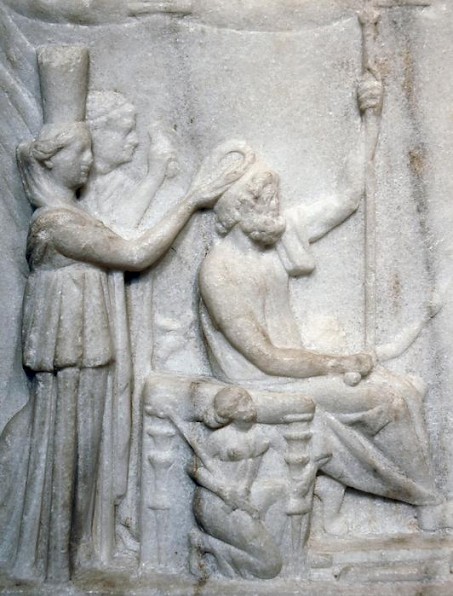
The ancient Greeks were deeply impressed by the two great epics written by the legendary poet Homer, the Iliad (describing an episode from the Trojan War) and the Odyssey (on the return of the hero Odysseus). Their admiration was not just limited to the literary value of the two poems. Homer, often lovingly called 'the poet', was regarded as the ultimate source of all sciences. On this picture, the author is sitting on a throne and has a scepter. The crouching figure in front and the (hardly visible) figure behind the throne symbolize the two poems. He receives a wreath from two people, who can be identified as the winged god of Time and a representation of the Inhabited World (Oecumene). The Iliad and Odyssey are presented as possessions of all civilizations and all ages.
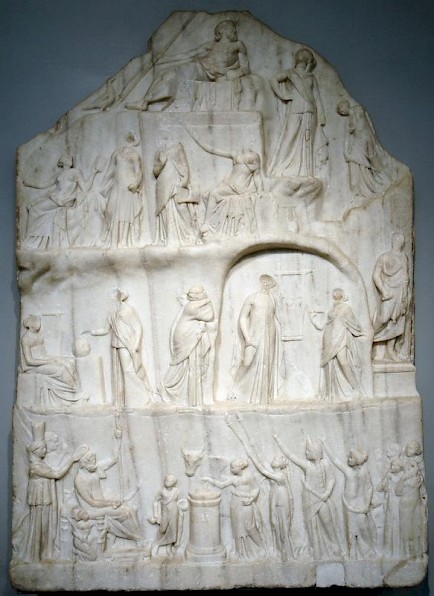
Today, the marble stela from which the coronation of Homer is a detail, can be seen in the British Museum. It was discovered in Bovillae, a small town along the Via Appia, not far from modern Castel Gandolfo, near Rome. However, it was almost certainly made in Egypt, in Alexandria, where the poet was worshiped as a god. To the Greeks overseas, this was only logical. Since the conquests of Alexander the Great (336-323), they were the masters of the world, but their social status in countries like Babylonia, Syria, and Egypt depended on their being recognizable as Greeks. People without Greek culture were barbarians and unfit to rule; so it really mattered if one was able to speak Greek fluently and quote from the right texts at the right moment. In the Museum and Library of Alexandria, Greek culture was a subject of serious study; in fact, the idea that there were 'classics' originates in the third century BCE in Alexandria.It is no coincidence that Time and Inhabited World are portraits of the Ptolemaic rulers Ptolemy IV Philopator and his wife Arsinoe III. The stability of their kingdom depended on the stability of the Greek elite.
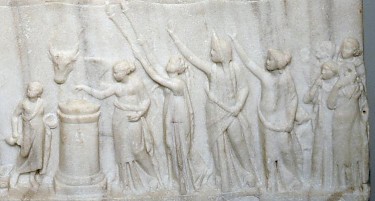
On the lowest of the three tiers of the stela, we can see a group of people approaching to worship the divine poet. Their names are written below them. From left to right, we can discern Mythos ("tale"), an altar and a bull, History (sacrificing incense), Poetry (with two torches), Tragedy (with a mask), Comedy. A small child represents Nature and looks for inspiration to Virtue, Memory, Faith, and Wisdom.
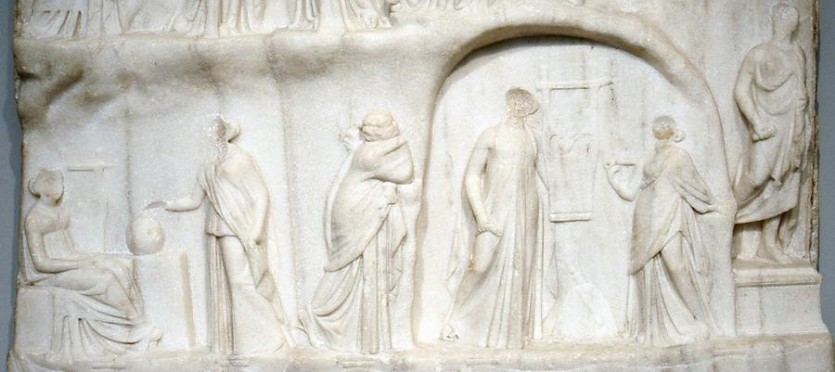
In the central tier, we recognize several Muses. Because they have attributes, they can be identified. To the left, the lady with the lyre must be Terpsichore, who inspires dancers and lyrical poets. The woman pointing at a celestial globe must be Urania, the Muse of astronomy. In a cave, we see the god Apollo, with his lyre, the patron of the arts. In front of him is Thalia, who protects comedy. She has no attribute, but as leader of the Muses she is placed next to the god.The figure to the right is a statue of a man with a scroll: the man who asked this stela to be dedicated near his tomb. Whoever he was, he must have been immensely wealthy, because the sculptor was a true professional, proud of his accomplishment, which he signed with his name: Archelaus of Priene.
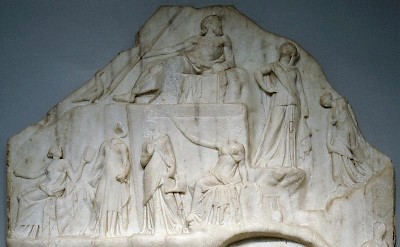
In the upper tier, we can see the other Muses. To the very left Clio looks up from her book. She is the protectress of the historians. Melpomene, who inspires the tragic poets, has a dagger. Above them is the father of the Muses, the supreme god Zeus. He is reclining on a mountain and carries a long scepter. To the left, we can see his eagle. The god looks atMnemosyne, the goddess of Memory and mother of the nine Muses. To the right, we can see Calliope. Her trumpet points down, and her body language betrays that she is in mourning, probably for the unknown scholar, who stands right behind her. Perhaps he was a philosopher, because Calliope protected those who were looking for wisdom. She also protected the composers of epic poems, like Homer.
Immediately left of Apollo is Polyhymnia, who covers herself in a mantle. She protects rhetoricians and is, with Apollo, the central figure of the composition. This may be coincidence, because the main figures are unrelated to her: Zeus, Homer, the deceased scholar.
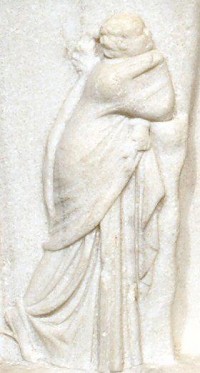
It is slightly ironic that the failure of the cult of Homer can be deduced from this stela. It was impossible to keep Greek culture untouched by native influences, as we can see when we look at the portrait of the dead man. Between his head and the feet of his mourning Muse, Calliope, we can see an Egyptian sign, ankh, which means 'life', and is often seen on native tombs. Apparently, our philosopher was not purist.
Nor were his king and queen, because in 217, they gave the native Egyptians the right to serve in the armies. Greek authors like Polybius of Megalopolis identified this with the beginning of the end of the Ptolemaic Empire, but it was inevitable. Once Greek culture, that passport to the elite, was identified with the ability to read and quote Homer and a limited set of other Greek authors, Greek culture was something that could be learned and acquired, and after the reign of Ptolemy IV, we see an increasing number of natives in the administration of the ancient kingdom along the Nile. Some of them have true Homeric names like Achilles and Hector. After all, the Iliad and Odyssey are possessions of all civilizations and all ages.